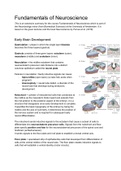College aantekeningen
Samenvatting Fundamentals of Neuroscience, UvA
This is an extensive summary for the course Fundamentals of Neuroscience which is part of the Neurobiology minor (from Biomedical Sciences) at the University of Amsterdam. It is based on the given lectures and the book Neuroscience by Purves et al. (2018). Dit is een uitgebreide samenvatting voo...
[Meer zien]





